After I left college, I moved into a tiny studio apartment, which basically meant I slept next to my kitchen. Unfortunately, it didn’t have a quiet refrigerator, and having it roughly 6ft from my bed and freestanding meant I got the full force of its noise output.
This has led me on a quest to find the quietest refrigerator possible. A few years of sleeping near a noisy one means I never want to experience it again!
Below, I’ve brought together my top finds for the best quiet refrigerators on the market. This is a 2023 refresh of my previous article with a greater emphasis on energy efficiency and usability.
How Many Decibels Is a Fridge?
Thanks to modern technology, most refrigerators have a noise output of 32-47 dB. A quiet refrigerator is any model that emits less than 42 dB. In real terms, this is about the same as a library or a quiet office.
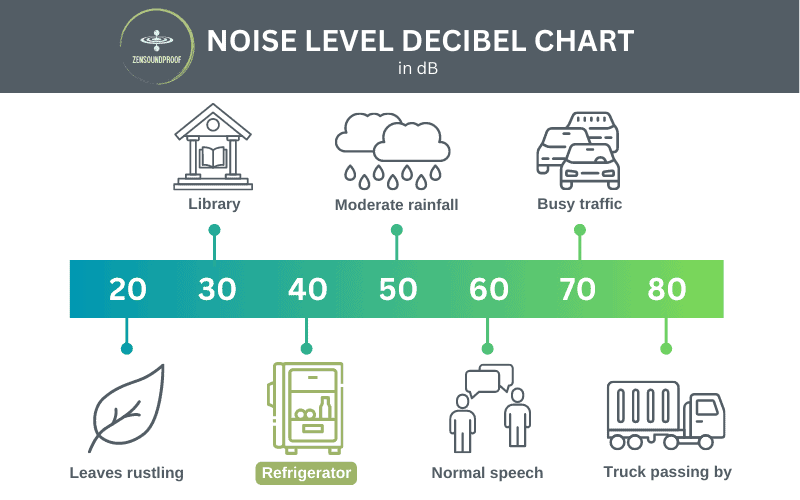
An explicit decibel level is by far the easiest way to compare products in the quiet fridge market. After all, if a manufacturer labels its refrigerator as quiet, it should have the facts to back it up.
Which Type of Refrigerator Is Less Noisy?
The quietest type of refrigerator is an absorption fridge, which is typically used in hotel rooms. They don’t have a motor, meaning they’re the closest to silent that you’ll find. Most people will have a compressor fridge in their homes, which are slightly louder, but are still quiet enough.
There are various types of refrigerators, which I’ve listed in a table:
| Refrigerator Type | Noise Output (dB) | Useful Features |
| Top freezer | 40-50 | More energy efficient |
| Bottom freezer | 40-50 | Less energy efficient |
| French door | 40-50 | Shorter and wider compartments |
| Side-by-side | 40-50 | Taller and narrower compartments |
| Undercounter | 35-45 | Space-saving |
| Mini fridge | 35-40 | Suitable for makeup, medication, etc. |
| Beverage cooler | 30-45 | Designed mainly for cans – useful for dorms, dens, etc. |
| Wine fridge | 30-45 | Nicer appearance – taller than beverage coolers |
Pretty much all refrigerators have a similar noise range regardless of size and type. Although there isn’t an explicit reason for this, some factors may include:
- Efficiency. A smaller fridge has less space to cool, meaning it theoretically doesn’t need to run as much.
- Insulation. On the other hand, larger models have more space for insulation, meaning they can retain their temperature better.
- Vibration reduction. Similarly, larger fridges have more room for vibration-reduction features, such as anti-vibration compressor blankets or silent blocks to dampen vibrations.
The bottom line is that the best quiet refrigerators cost a bit more money. Better build quality generally means better insulation, more efficient parts, and better design. Of course, this does come at a price.
What Matters to Reduce Noise?
There are some more important factors to consider when thinking about refrigerator sound levels. These include:
- Ice makers – these create potentially unnecessary noise.
- A more energy-efficient fridge will work less, meaning less fan noise.
- Despite hot air rising, top freezer refrigerators are more efficient than bottom freezers because of the distance from the compressor. To put it simply, if the freezer sits at the bottom next to the compressor, it means the freezer has a warmer environment to deal with to reach freezing temperature. As such, the system consumes more energy.
- Maintenance is key to keeping your refrigerator quiet. Without regular cleaning, even the most silent fridge will eventually start making noise.
Although compressor refrigerators are the noisiest (more so than thermoelectric), we can get around this by looking at inverter compressors. In short, these run consistently at controlled speeds rather than simply being on or off.
It reduces wear on the components but also means less noise because the rotor can run at slower speeds. As with pretty much any rotor-based technology, this is one of the main sources of noise in a refrigerator.
Our Top 8
Where possible, my quietest refrigerators have a decibel rating for convenience. I’ve divided my reviews into different refrigerator types so you can narrow your search more easily.
1. Quietest Top Freezer Refrigerator: Galanz GLR10TBKEFR Retro Refrigerator
- Top Freezer
- Capacity: 10 cu. ft.
- Noise Level: 42 dB
- Energy Use: 325 kWh/yr
- Dimensions:
Depth: 23.74″
Width: 27.48″
Height: 61.81″ - Warranty: 1 Year
The Galanz GLR10TBKEFR Retro Refrigerator is a fairly quiet and energy-efficient top freezer model. Considering its appearance and price point, it’s a pretty decent pick.
Build
This is a top freezer model with 10 cu. ft. of capacity. While it’s not the biggest refrigerator in the world, it should be enough for a couple or small family. The space is divided between the fridge and freezer, which are 2.42 and 7.42 cu. ft. respectively.
It has adjustable glass shelves and manual control dials, meaning you can always keep it at the right temperature. There’s also a crisper drawer for keeping all your veg fresh.
Noise Level
At 42 dB, this is a fairly quiet refrigerator. Although not stated explicitly (but based on my research), it’s fair to assume this is the noise output when the compressor is running. In turn, it’ll be quieter when the compressor is off.
Energy Efficiency
The Galanz is Energy Star rated with an annual consumption of 325 kWh per year. Based on average energy prices, it could cost as little as $39 a year to run.
Downsides
I discovered that users’ main critiques relate to the fridge handles. They’re plastic but designed to look like chrome. While opening the door doesn’t put much pressure on them, they cheapen the overall look somewhat. But, if they do break, you’re covered by a 1-year warranty.
- Sleek retro design.
- Noise emissions of 42B.
- Suitable for smaller homes or as a secondary refrigerator.
- Energy Star rated.
- Plastic handles feel a bit cheap.
2. Quietest Bottom Freezer Refrigerator: Galanz GLR74BS1E04
- Bottom Freezer
- Capacity: 7.4 cu. ft.
- Noise Level: NC
- Energy Use: 350 kWh/yr
- Dimensions:
Depth: 20.75″
Width: 23.7″
Height: 63.27″ - Warranty: 1 Year
Despite being similar in design to the top freezer model above, the Galanz GLR74BS1E04 has slightly less capacity. That said, it’s also smaller, which, in my opinion, makes it a good pick for compact kitchens.
Build
The 7.2 cu. ft. of space is split across the fridge and freezer, which are 4.56 and 2.96 cu. ft. Sure, this isn’t the biggest refrigerator ever, but it should be fine for 2 people living in an apartment.
The fridge has adjustable shelves and door space, while the freezer is split into 4 shelves. You control the temperature using a manual thermostat, and you can fit it as a counter-depth refrigerator.
Noise level
Unfortunately, we don’t have an explicit decibel rating for this refrigerator. However, it’s the same brand as the top freezer model above, and my findings show this one actually scores an impressive 4.3 out of 5 stars (400 + users feedback). As such, you can expect build quality and noise insulation to be similarly performant.
That said, you could expect the compressor to run more often because of the freezer being at the bottom, which is less energy efficient and often generates more noise.
Energy Efficiency
As noted above, bottom-freezer models are less efficient because of the freezer’s location in relation to the compressor. This is evident in its energy consumption rating. Annually, it’ll use 350 kWh. However, this isn’t considerably more than the top-freezer Galanz above, although it’s still Energy Star rated.
Downsides
After scouring users’ feedback, I found a few complain that the potential ice buildup in the freezer can impact the temperature. As there’s no auto defrost, it’s something you’ll have to handle manually. In my experience, regular defrosting should keep the issue under control.
- Bottom freezer feels surprisingly spacious.
- Ideal for a small family.
- Noise level is decent.
- No dB rating.
- Energy efficiency is disappointing for the size.
3. Quietest Side-by-Side Refrigerator: Kenmore 36” Refrigerator and Freezer
- Side-by-Side
- Capacity: 25 cu. ft.
- Noise Level: 42 dB
- Energy Use: 702 kWh/yr
- Dimensions:
Depth: 33.81″
Width: 35.5″
Height: 69.25″ - Warranty: 1 Year
The Kenmore Side-by-Side Refrigerator is a good compromise between space and capacity. While it’s not Energy Star rated, the annual running cost still isn’t too high.
Build
This fridge has a total capacity of 25 cu. ft. that’s split into 15.46 for the refrigerator and 9.11 for the freezer. The fridge has numerous adjustable shelves, a salad crisper, and loads of door space. You’ll find a similar layout in the freezer, but there’s also an ice maker and water dispenser.
Noise Level
With noise emissions of 42 dB, this is the same as the other models I’ve reviewed so far. It shouldn’t be too noticeable when it’s set up and running in your kitchen.
However, the ice maker can increase the noise output, although this isn’t unique to this model. In my experience, the noisiest bit is the ice actually falling into the basket, as the freezing process is similar to the rest of the fridge’s processes. If you think it’ll be an issue, just don’t make ice.
Energy Efficiency
As mentioned, this refrigerator isn’t Energy Star certified. Its energy consumption is 702 kWh per year, which equates to around $84. According to its energy guide label, it’s on the lower end of the scale for similar models.
However, customers state it doesn’t stay on for long periods. You can manually adjust the temperature to suit, too, meaning it doesn’t need to run as often.
Downsides
Users mainly comment on the ice maker, saying it’s loud and a bit inconvenient. But we’ve already mentioned a solution to that (buy an ice tray). Others say it could do with more storage space, but it’s designed as a compact model.
- Compact side-by-side refrigerator.
- Operates at 42 dB.
- Acceptable storage space for smaller kitchens.
- Comes with all the necessary features.
- Ice maker is loud.
4. Quietest French Door Refrigerator: Smad Counter-Depth French Door Refrigerator
- French Door Refrigerator
- Capacity: 22.5 cu. ft.
- Noise Level: 42 dB
- Energy Use: 588 kWh/yr
- Dimensions:
Depth: 29″
Width: 35.8″
Height: 69.9″ - Warranty: 1 Year
The Smad Counter-Depth French Door Refrigerator combines 2 big categories: counter-depth and French door. This offers convenient access to the refrigerator and suitable placement in your kitchen.
Build
It has 22.5 cu. ft. of storage space split across the fridge (15.87) and the freezer (6.61). Sure, the freezer could be larger, but it’s enough for storing anything you need immediate access to. If you have the space, I’d recommend combining it with a separate freezer.
The French door design makes it easy to access food and provides more flexible door storage. Also, the glass shelves are spill-proof, meaning they have a raised lip. While not a massive feature, it does stop liquids dripping down the back if you don’t clean them up in time.
Noise Level
At 42 dB, it’s on par with the Galanz and Kenmore models. Based on my usage, this is a perfectly acceptable noise level for a kitchen-based refrigerator. After you consider other ambient noise in a house (between 45 and 55 dB), you won’t really notice the compressor running.
Energy Efficiency
This refrigerator has an annual energy consumption of 588 kWh. It’s therefore much more efficient than the Kenmore, as we could put the 2 models in the same general category. Based on average energy prices, it’ll cost around $72 a year to run.
Downsides
The main downside mentioned by users is the bottom crisper drawer. It’s the full fridge width, meaning you must open both doors to access it. This isn’t a massive problem, but the point of 2 doors is greater flexibility.
- Plenty of storage – ideal as a family fridge.
- As quiet as other larger refrigerators.
- Includes moderate bottom freezer.
- Spill-proof shelves.
- Bottom crisper drawer is inconvenient.
5. Quietest Under-Counter Refrigerator: HCK 24” Undercounter Fridge
- Undercounter
- Capacity: 5.1 cu. ft.
- Noise Level: 39 dB
- Energy Use: 304 kWh/yr
- Dimensions:
Depth: 23.6″
Width: 23.6″
Height: 34.1″ - Warranty: 1 Year
I’ve included this HCK refrigerator as my pick for an undercounter refrigerator, but it also appears on my list of quiet beverage coolers. While its drawer design is primarily for drinks, nothing is stopping you from storing food in it.
Build
As mentioned, this is designed as a beverage cooler. However, the shelf layout is pretty standard, as are its cooling temperatures. You could therefore use it for storing food because it certainly gets cold enough. It does only have 5.1 cu. ft. of space, but this is fairly standard for an undercounter model.
It’s outdoor-rated, meaning it’s splash-proof and has pretty decent insulation. Due to its size, it lacks standard features like shelves and a crisper drawer. But it’s ideal for use in an outdoor BBQ area, den, or small apartment kitchen.
Noise Level
Its noise output is 45 dB when the compressor is running, making it marginally louder than the full-size models above. However, it’s only 39 dB when the compressor is off. In my experience, this is absolutely fine because it doesn’t run very often anyway due to its efficiency.
Energy Efficiency
This model’s annual energy consumption is 304 kWh, which is pretty good. Bear in mind, though, it might prove less efficient if you run it outdoors in warm conditions. The compressor will have to work harder, meaning it’ll use more energy.
Downsides
The biggest downside is that there’s no freezer compartment. However, this is quite standard for undercounter refrigerators. If you need a freezer and are willing to sacrifice some fridge capacity and energy efficiency, the ICEJUNGLE could be a viable alternative.
- Easy-to-use compact fridge.
- Costs around 9 cents a day to run.
- Simple to install under counters.
- Quite expensive.
- Drawer design won’t suit everyone.
6. Quietest Mini Refrigerator: Black+Decker BCRK17W Mini Fridge
- Portable Mini Fridge
- Capacity: 1.7 cu. ft.
- Noise Level: 45 dB
- Energy Use: 201 kWh/yr
- Dimensions:
Depth: 18.5″
Width: 17.5″
Height: 19.7″ - Warranty: NC
The Black+Decker BCRK17W Compact Refrigerator skirts the line of what we can consider to be a mini fridge. Typical mini fridges are desktop models, whereas this is more of a small undercounter.
I won’t review it in depth here because I have a separate article on mini fridges, where this is my top pick. I recommend reading it in full to see if this model is the most suitable for your needs.
7. Quietest Beverage Refrigerator: Vremi 120 Can Beverage Cooler
- Beverage Mini Fridge
- Capacity: 3.2 cu. ft.
- Noise Level: 42 dB
- Energy Use: 288 kWh/yr
- Dimensions:
Depth: 17.3″
Width: 18.9″
Height: 33.3″ - Warranty: 1 Year
The Vremi 160 Can Beverage Cooler is my top pick in my article about beverage fridges. It’s a decent compromise between size, price and noise output. Based on my research, the noise output of 42 dB is based on its compressor running. As with other refrigerators on this list, it probably sits around 38 dB when it’s off.
Its energy efficiency is pretty good for its size and cooling performance, as it can drop down to 34F. If you’d like to read more about the Vremi and my other beverage cooler picks, check out the full article.
8. Quietest Wine Refrigerator: Vinerie 46 Bottle Wine Cooler
- Wine Refrigerator
- Capacity: 4.24 cu. ft. (120L)
- Noise level: 40 dB
- Energy Efficiency: 220kWh/yr
- Dimensions:
Depth: 22.7″
Width: 23.5″
Height: 34.5″ - Warranty: NC
The Vinerie 46 Bottle Wine Cooler is very similar to the Vremi above. The biggest difference between them is looks. Arguably, the Vinerie is classier: it has wood shelves and dual zone cooling that’s perfect for wine.
Again, I won’t review it in full here, as I have a dedicated article on quiet wine coolers. Check that out for the complete review and other recommendations in this category.
What Features to Look for
When looking for a quiet refrigerator, sound emissions are obviously the most important factor. Aside from this, there are other things to consider.
Cubic Feet
We measure a refrigerator’s size in cubic feet, which is its internal capacity. As a general rule, a 2-person family should have 8-10 cubic feet of storage in their refrigerator and 4 in the freezer. You should add up to 2 more cubic feet for each extra family member.
Size
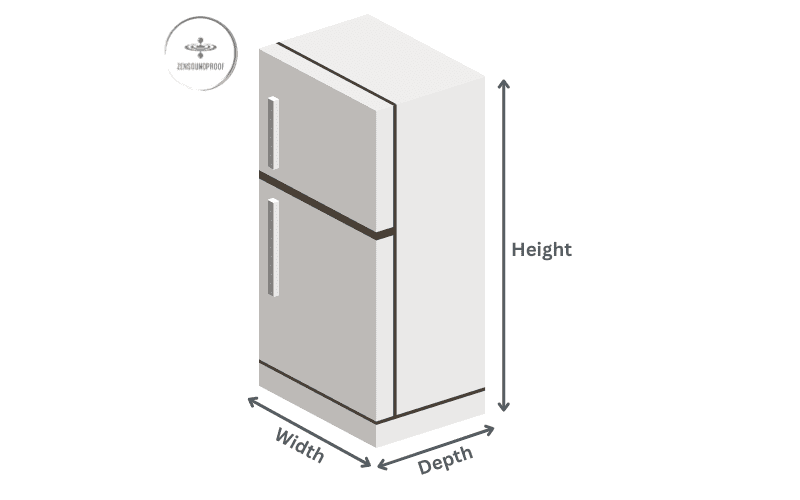
Of course, a refrigerator’s external measurements are just as important when picking the right model. The best place to start is by measuring your current fridge and the space it sits in.
A counter-depth refrigerator is probably the only one where size really matters. As standard, they’re 30 inches deep, which is the same as normal kitchen counters. This measurement doesn’t include handles, though.
All refrigerators list their dimensions, so it shouldn’t be difficult to find the right one.
Energy Efficiency
An energy-efficient refrigerator will generally make less noise because it doesn’t have to run the compressor as much. We measure energy usage in kilowatt hours (kWh), and the price you pay depends on your energy provider. Obviously, an Energy Star certified refrigerator will also save you money.
The easiest way to know if your refrigerator is energy efficient is with the Energy Star rating. It’s a government rating that has specific standards for appliances, including refrigerators.
However, not all fridge types have a certification range. Instead, here’s a table of some typical values to help you understand what an energy-efficient fridge looks like:
| Fridge Type | Cooling Technology | Annual Energy Consumption (kWh) |
| Top or bottom freezer | Compressor | 300+ |
| French door, side-by-side | Compressor | 560+ |
| Mini fridge | Compressor/TEC | 239+ |
| Beverage fridge, wine cooler | Compressor/TEC | 150+ (more typically 250+) |
Warranty
Manufacturers usually offer a 1-year warranty on a refrigerator, although they sometimes go up to 5 years. Considering a well-made fridge can last a decade, it’s worth finding one with a decent warranty.
For an expensive refrigerator, consider covering it through your home warranty. This can cost up to $600 a year but usually covers all major appliances. If you’re investing in a decent quiet refrigerator, it makes sense to keep it covered.
Setup
As mentioned, your options for refrigerator style include French door, stacked, or side-by-side. They’re generally self-explanatory.
A stacked model (with the freezer on top) is the most budget-friendly option and is more energy-efficient than a bottom freezer refrigerator. You sacrifice some space in the freezer space, though, as it equates to at most 40% of the total storage capacity.
A side-by-side is best if you want almost equal storage in each. As the name suggests, the fridge and freezer are next to each other.
A French door refrigerator usually has a bottom freezer drawer, although some have a French door instead. According to the Energy Star guidelines, fewer doors mean better energy efficiency.
But a French door refrigerator is one of the biggest models on the market, making them suitable for larger families.
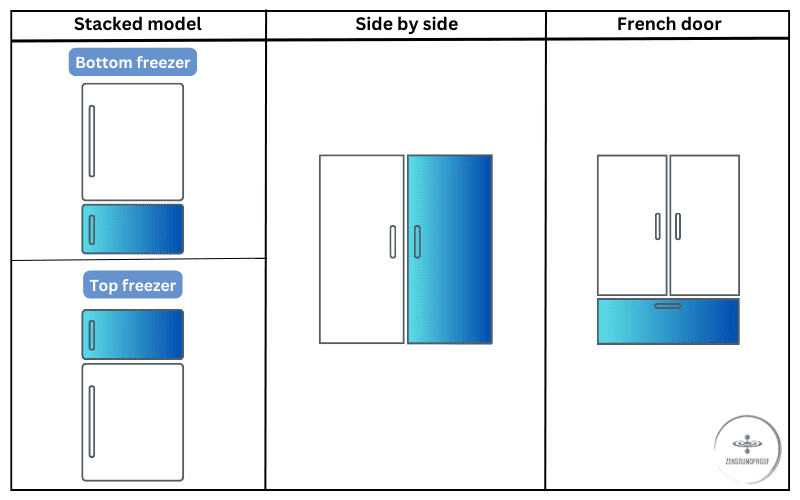
You have fewer options with compact or portable refrigerators. These are simpler models, often designed to cool drinks or store medication/beauty supplies. They’re also usually the quietest refrigerators because they use slightly different cooling technology.
Technology
For home refrigerators, your main option is compressor technology to circulate cold air. It works the same as an AC unit. You can check out my other article on mini-fridges to understand how compressor fridges work.
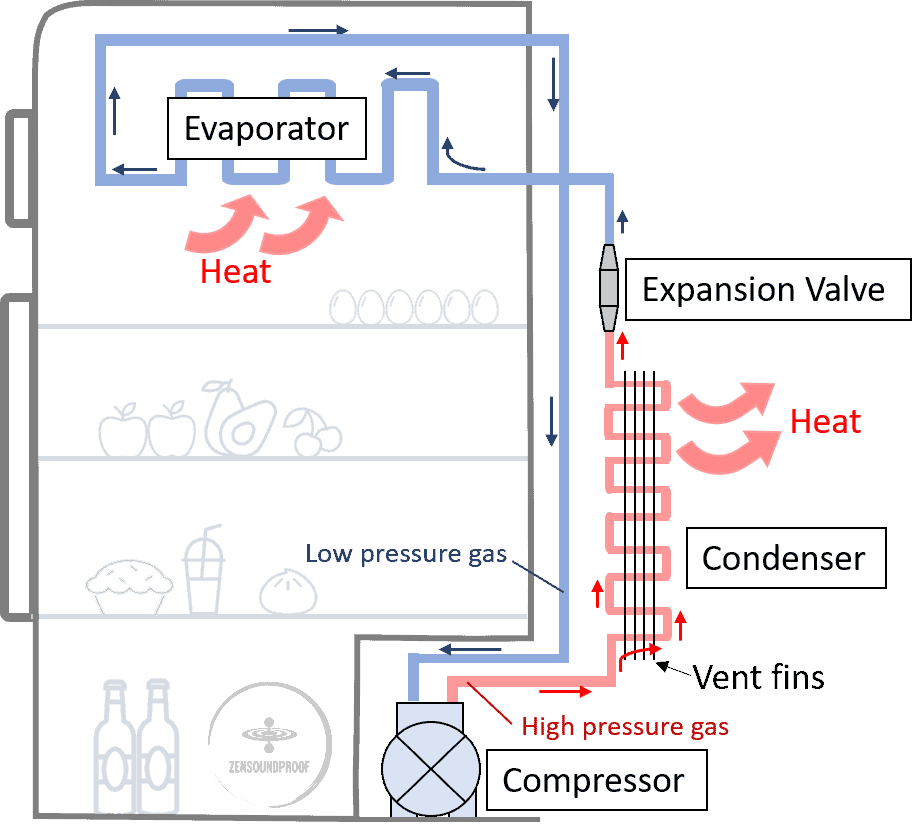
Portable fridges use semiconductor/thermoelectric cooling. The technology is quieter than a compressor as I explained in another article here. That’s why the portable model I review above can go as low as 25 dB.
Over time, your refrigerator’s compressor might start making noise. I’ve written an article about how to quiet a noisy refrigerator compressor, so check that out if you need more information.
Features
Aside from keeping food cool, what else does a refrigerator need to do? Well, that largely depends on preference, as everything else is an extra feature.
Water Cooler
At the most basic level, this is a tank in the fridge door that stores water (or wine). You pour the water in, it chills, and then you dispense it through the front of the fridge.
More complex models connect to your mains water supply, drawing water directly into the fridge. Although not a noisy process, it does add another thing that can make noise if it goes wrong.
If you’re willing to just top the water up when needed, a tank is a better option.
Ice Maker

Many fridge freezers feature an automatic ice maker. Again, these usually connect to your mains water supply. The fridge draws in water, freezes it, and then dispenses it into a holder.
Overall, this can be a very noisy process, even if the noises are normal.
If you’re looking for a quiet refrigerator, steer clear of an ice maker. Plus, there’s nothing too difficult about filling some ice trays and doing it the old-fashioned way.
Shelves and Salad Crisper
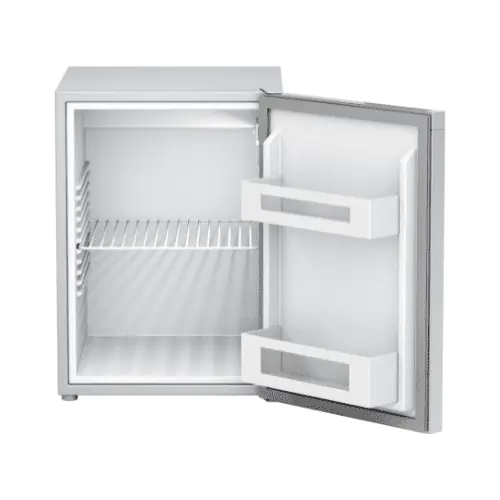
Obviously, shelves are a fundamental feature in a refrigerator. Most use glass shelves, which are easy to clean and sanitize. Ideally, the crisper should be humidity controlled otherwise it won’t keep things fresh.
Look for shelves that have a lip. It prevents spills from running down the back of the fridge where they can start to smell. Some models call it spill-proof shelving, so keep an eye out for that.
Thermostat
Granted, this isn’t an extra feature, but it’s worth mentioning. Your refrigerator should have some sort of internal temperature control. Along with energy consumption, this’ll affect sound.
The most basic version is a dial that you turn, but others have LED temperature displays. Dials without a temperature scale are fine but might take some trial and error to find the right temperature.
Final Thoughts
In my experience, choosing a quiet refrigerator can have benefits for both quiet enjoyment of your home and the appliance’s energy efficiency. I hope this article has given you enough information to make an educated choice on the best model for your needs.
Usually, I recommend my top pick, but I’ve tried to provide a suggestion for each main category of refrigerator. The most suitable one for you will depend on space, family size, and budget.
If you’re looking for more options for a mini fridge, check out my other article on my Top 5 Quiet Mini Fridges. Also, if you’re looking to simply make your existing fridge quieter, check out article on how to quiet a noisy compressor.
Do you have suggestions for other good quiet refrigerators? Let me know in the comments below.









4 thoughts on “Top 7 – What is the Best Quiet Refrigerator? Noise Level Comparison”
Thank you for that detailed article. I am so grateful for this information! Wow. I hope to read more soon.
Sincerely,
Laura B
Single-number dB levels are devoid of meaning for describing noise from fans and compressors because they generate tonal noise, perfectly hidden in the single number. Tonal noise is the most bothersome. It is industry standard, however, to act as if a single number dB suffices in the noise description so models rated highly for noise will generate noise complaints.
Thank you for your article. I’d already bought a new fridge by the time I read it. My new Bosch fridge (only) is rated at 39dB, 110kw/h per annum. I considered a slightly taller model with a water dispenser. It uses more power, and costs +- $250 more for only 10cm extra space. I also wonder if a water dispenser creates a cooling ‘weak point’ requiring more power use to counter. I thought ‘yagni’. Anyhoo, feels like I made the right decision, vindicated by your informative post.
Hi Ludovic,
Thank you for the insights you brought to the subject of quietness in compressor design. I have two questions — both practical in nature.
One: Is a “linear” compressor (such as LG uses in its refrigerators) the same as a “scroll” type compressor, and if not, which is the quieter of the two?
Two: Could you recommend the quietest larger refrigerator currently available? If there is a fridge only, without a freezer, that would be even more desireable.
Please advise. Thanks.